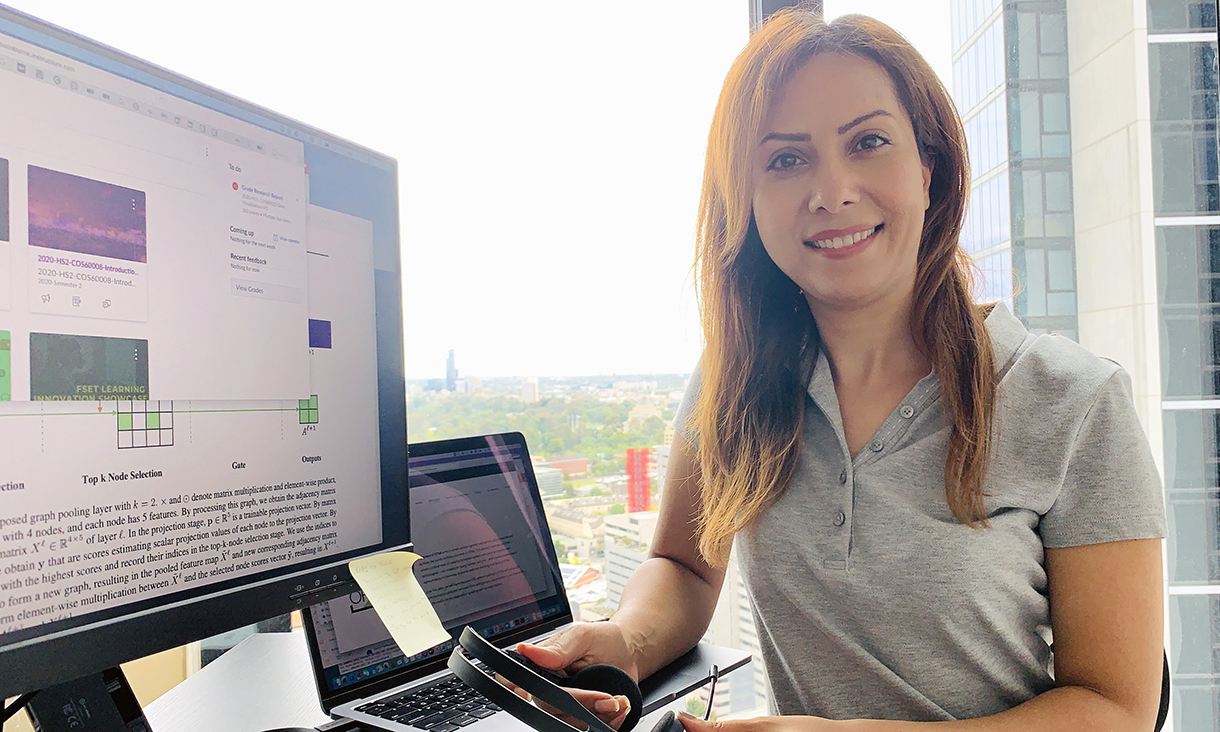Q and A with Swinburne Superstar of STEM Dr Dana Rezazadegan

Dr Dana Rezazadegan is bringing innovative solutions to real-world problems by creating systems that can think and act intelligently.
In summary
- Superstar of STEM Dr Dana Rezazadegan is enthusiastic about the use of AI and robotics to improve people’s lives
- She shares some thoughts on her work and improving gender diversity in STEM fields
Dr Dana Rezazadegan is a lecturer in artificial intelligence (AI) and data science at Swinburne University of Technology with a passion for using AI and robotics to improve people’s lives. In December2020, she was selected as one of 60 Superstars of STEM – an Australian Government initiative to increase the visibility of women in STEM.
We spoke with Dr Rezazadegan to find out more about her work and the positive impact it could have on our society.
What is your field of research?
Artificial intelligence, robotic vision, computer vision and deep learning, which is a machine learning technique that teaches computers to learn by example, like humans.
How did you get into this field?
I was fascinated by robots and programming since my childhood. I was recognised as a talented student in mathematics through high school competitions, such as the national mathematics Olympiad in Iran.
I studied electrical engineering in my bachelor and master programs. I focused on electronics as an undergrad student and moved to control engineering as a postgrad, where I worked on autonomous underwater vehicle (AUV) control and navigation. This led me to the robotics world. I heard of AI at the same time, which highly excited me, so I decided to broaden my knowledge in the field by having a taste of overseas education.
I applied for a funded PhD program in robotics and computer vision at Queensland University of Technology, where I did research on AI and mixing it with vision to have an assistive robot who can see, learn and assist its human peer more intelligently.
What kinds of practical applications does your research have?
Today’s lifestyle has brought AI and robotics together in many aspects of human life. For example, many apps that we use daily to facilitate our activities use AI behind the scenes, including sport apps, online shopping, internet banking and social media – not to mention the use of AI for autonomous cars, assistive robots, shipping and so on.
Besides all of that, I’m particularly interested in human–robot collaboration and applying AI in healthcare settings such as helping patients with dementia, using robots to motivate kids going through rehabilitation, precision medicine, early recognition of mental disorders from social media and so on.
Tell us about your involvement in the Superstars of STEM program. Why do you think this program is important?
My mentors and some colleagues made me aware of the program. It’s a competitive process, so I had to apply and go through assessments and interviews, and eventually I was selected!
Due to the gender inequity that we have in STEM fields in Australia, it’s a necessity for all of us to step up to encourage and help female students to enter STEM education and have a successful career. This program is important as it aims to raise the visibility of women in STEM fields in the public and give women more courage to take critical roles in academia and industry by smashing the imposter syndrome and fear of being in gender-polarised fields.
I believe the program’s impact is not just for ‘superstars’, but for all people who are following it. Hopefully, it can gradually change society’s beliefs on gender diversity in specific fields.
What will you be doing as part of the program?
I’m going to share my story through media interviews and by speaking at universities and schools. I’ll talk about my research projects, how I got here and opportunities for others to join the STEM field. I’m sharing my research activities and achievements in social media for three purposes. Firstly, I to give my research better recognition and encourage people in the field to approach and start a collaboration. Secondly, I want to be a role model and show other women that if I can do all these things, you will be able to do even better, you just need to put in the work and make an effort. Finally, I want to help women who want to pursue their STEM education or career by providing them with guidance or direct help.
My main aim in joining this program is to help to improve gender diversity in STEM fields by encouraging women to enter the field. There are many women who are interested in STEM, but they think they are not going to be as successful as men and it’s better to choose fields that are known as more suitable careers for women, by society or culture. I want to try to change this belief by talking to students and encouraging them to select their major free from society’s pressure.
What advice do you have for aspiring superstars of STEM?
Believe in yourself. Smash the fear of having failures in your career because there is no successful person who hasn’t made mistakes. Aim for progress not perfection; it’s more than enough to be the best version of yourself, get help when you need it and, finally, don’t forget to have fun on your journey!
What’s something that you do to improve gender equity in the workplace or beyond?
I have some female students in the units that I teach and I can see they are much less confident than male students, though in terms of talent and merits they are at the same level, sometimes higher. I usually make them participate in class activities deliberately to show them they are good enough to volunteer to lead a part of class projects and raise their confidence. It mostly works, even if they feel uncomfortable at first.
I’m also having interviews with media to tell my story, sharing not just my achievements but also failures and challenges that I faced. I believe it can inspire many women like me who are trying to push boundaries, but who might be afraid of failure.
-
Media Enquiries
Related articles
-

- Technology
- Science
- Engineering
Victorian students drive green energy transition through international hydrogen competition
Swinburne’s KIOSC, in collaboration with Horizon Educational and Gippsland Tech School, co-hosted the Hydrogen Grand Prix in Melbourne.Friday 26 July 2024 -

- Technology
- Health
New MedTechVic prototypes to transform everyday lives of people with a disability
Swinburne’s MedTechVic has revealed three new prototypes designed through the joint Health-led Manufacturing Innovation Program, in partnership with the Australian Medtech Manufacturing Centre and Safer Care Victoria
Friday 19 July 2024 -

- Science
Skin, scales and fish tails: using collagen to turn fish guts into gold
New research from Swinburne could transform the sector by converting high value collagen proteins from seafood by-products into cosmetics, food, and pharmaceuticals.
Tuesday 02 July 2024 -

- Education
- Engineering
Transforming the lives of refugee engineers through the EPIC Program
Swinburne has been partnering with the Level Crossing Removal Project (LXRP) on the Engineering Pathway Industry Cadetship (EPIC) program, helping refugee engineers gain international qualifications for the Australian workforce through an 18-month paid cadetship program.
Thursday 20 June 2024 -

- Science
- Engineering
Submarines in the future could self-identify cracks and self-heal thanks to Swinburne researcher
Thanks to the work of Dr Nisa Salim from Swinburne University of Technology’s School of Engineering, future submarines could self-identify microcracks and self-heal using a new kind of carbon fibre reinforced polymer composites.
Monday 17 June 2024

